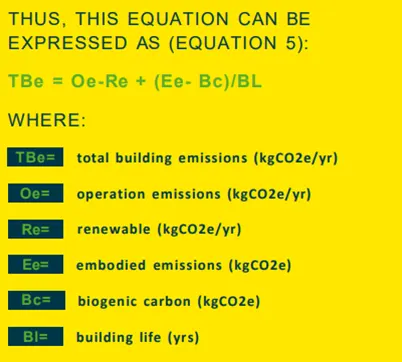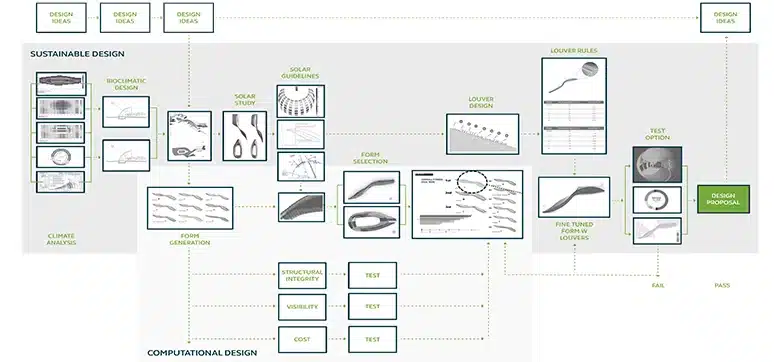An increasingly warmer planet requires buildings that adapt to changing conditions, while also reducing greenhouse gas (GHG) emissions to slow down and reduce the rate of related changes. Such adaptation is not typically possible in most conventional buildings of the past century, generally designed to solve overheating problems by using more energy for mechanical cooling. Even if the electrical grid is powered primarily by renewables, buildings must be designed to be future-proof and resilient by ensuring the thermal safety and comfort of occupants when it fails.
 It is necessary to improve the performance of the buildings we design by reducing their GHG emissions, energy and water consumption, and waste production to reduce anthropogenic emissions and have any real impact on climate change.
It is necessary to improve the performance of the buildings we design by reducing their GHG emissions, energy and water consumption, and waste production to reduce anthropogenic emissions and have any real impact on climate change.
Passive Cooling and Heating
Most current research on sustainable architecture focuses on improving established technologies, such as HVAC systems, while making buildings tighter and better insulated. Passive architecture can harness energy flows through smart building design. Passive cooling systems can transfer this heat from a building to various natural heat sinks, using heat flow paths that do not exist in conventional buildings. The enclosure design has a significant effect on the performance of the building and on building emissions. Heat can flow from interior to exterior, or exterior to interior, by conduction, radiation, or convection, and the building will always try to attain thermal equilibrium with the out- doors. These flows occur through the different components of the building fabric: conduction through the solid components of the building, radiation through windows, and convection through windows, or another opening in the building.
 This figure shows heat gains and losses through a building envelope. In a warm climate, the sum of all these energy flows is higher than the losses resulting in a higher indoor than exterior temperature. In contrast, in a cold climate, the flow from the interior to the exterior will be higher and the indoor temperature could be lower than comfort. However, in some climates, if conditions are appropriate, it is possible to promote heat losses by ventilation, radiation, and evaporation (Qir, Qev, Qcv) to provide cooling, which generates, through natural means, an average Indoor temperature that is lower than the average outdoor temperature. These loss processes are called passive cooling systems.
This figure shows heat gains and losses through a building envelope. In a warm climate, the sum of all these energy flows is higher than the losses resulting in a higher indoor than exterior temperature. In contrast, in a cold climate, the flow from the interior to the exterior will be higher and the indoor temperature could be lower than comfort. However, in some climates, if conditions are appropriate, it is possible to promote heat losses by ventilation, radiation, and evaporation (Qir, Qev, Qcv) to provide cooling, which generates, through natural means, an average Indoor temperature that is lower than the average outdoor temperature. These loss processes are called passive cooling systems.
Passive cooling systems use natural processes, harnessed through design and appropriate materials, to collect, store and distribute energy to provide thermal comfort with no emissions. For buildings to cool passively, they must transfer energy by conduction convection and radiation from a higher-temperature interior to a lower-temperature exterior heat sink. Passive cooling strategies require certain climate conditions and a building, especially an envelope, designed to promote the necessary energy flows.
 In locations where passive cooling systems cannot provide thermal comfort during the overheated period, they can still reduce peak cooling loads, reducing the size of the mechanical cooling system and the period during which it will be used. For passive cooling systems to be most effective heat gains must first be reduced by implementing strategies such as shade and insulation. Passive cooling systems are classified according to the environmental heat sinks transferring and storing building energy, ambient air, water evaporation, upper atmosphere, and under-surface soil.
In locations where passive cooling systems cannot provide thermal comfort during the overheated period, they can still reduce peak cooling loads, reducing the size of the mechanical cooling system and the period during which it will be used. For passive cooling systems to be most effective heat gains must first be reduced by implementing strategies such as shade and insulation. Passive cooling systems are classified according to the environmental heat sinks transferring and storing building energy, ambient air, water evaporation, upper atmosphere, and under-surface soil.
Natural Ventilation
Providing direct human comfort through ambient air movement and by lowering of indoor temperature evacuating air from the interior by convection, mostly by daytime ventilation. The heat sink is the ambient air.
Night Ventilation
Opening the building to cool the structural mass of the interior during the night and closing the building during the daytime. The heat sink is the ambient air.
Direct Evaporative Cooling
Evaporative cooling of the air, which is then introduced into the building, lowers the temperature of the air while increasing humidity. The heat sink is the ambient air and cooling is by water evaporation. Indirect evaporative cooling: Cooling of a building component with evaporative cooled fluid, so the interior space is cooled without elevation of humidity. The heat sink is the ambient air and cooling is by water evaporation.
Radiant Cooling
Transferring longwave radiant energy from the building to the upper atmosphere during the night. The heat sink is the upper atmosphere.
Soil Cooling
 Cooling the soil and using it as a heat sink for the building. The heat sink is the earth. It is also possible to improve thermal comfort in cooler climates by reducing heat losses to the exterior and increasing solar gains by implementing passive heating systems. A passive solar building uses solar radiation as a heating source requiring direct solar radiation to strike a surface and heat it. Three groups generally comprise passive heating systems classifications: direct gain, indirect gain, and isolated gain systems.
Cooling the soil and using it as a heat sink for the building. The heat sink is the earth. It is also possible to improve thermal comfort in cooler climates by reducing heat losses to the exterior and increasing solar gains by implementing passive heating systems. A passive solar building uses solar radiation as a heating source requiring direct solar radiation to strike a surface and heat it. Three groups generally comprise passive heating systems classifications: direct gain, indirect gain, and isolated gain systems.
Direct Gain Systems
The actual living space is the solar collector, heat absorber, and distribution system. Indirect Gain Systems Thermal mass is located between the sun and the living space. Isolated Gain Systems They have their integral parts separate from the main living area of a house. Both passive heating and passive cooling systems reduce the energy needed for heating and cooling and GHG emissions from the operation of the building.
The figure above shows a proposal for a courtyard in the Middle East implementing multiple passive strategies to improve outdoor comfort. These strategies include shade, air movement, evaporative cooling, thermal mass with embedded pipes, and green surfaces to improve outdoor comfort. Together, to elevate occupant experience and thermal comfort in the courtyards. Shade is needed most of the year and in this climate, provides two significant benefits – it blocks solar radiation to the body and reduces solar gains on exterior surfaces. Solar radiation increases personal discomfort on warm days.
Similarly, exterior surfaces without mitigation absorb solar radiation, storing it and then re-radiating it as longwave radiation towards the courtyard, negatively affecting thermal comfort. During days with high outdoor temperatures, the implementation of other strategies must occur. Air movement improves comfort when the air temperature is below 32°C. Fans provide air movement in the dining area, and an exterior solar chimney allows warm air to exit the courtyard.
Air movement is helpful throughout most of the year, but during some seasons, its temperature is too high for comfort and must be evaporatively cooled before it passes through the body. Evaporative cooling reduces air temperature by evaporating water when the air is hot and dry and is activated through misters that cool the air above the dining areas while water features at the ground and lower levels provide additional evaporating cooling, also enhancing the qualities of the space with aesthetics and sound. Evaporative cooling is most effective during the daytime when relative humidity is lower, and temperatures higher, and during the shoulder seasons when transitioning to the hot muggy season.
 Green surfaces protect and shade the west wall so that it does not overheat. The courtyard floor includes water and green areas that also reduce solar gains. It is also possible to cool the outdoor spaces around the building improving the performance of the building’s passive cooling systems. The Xylem improves outdoor thermal comfort with a vegetated roof and water circulation for radiant cooling in addition to shading and natural ventilation. It improves outdoor thermal comfort while mitigating the heat island effect.
Green surfaces protect and shade the west wall so that it does not overheat. The courtyard floor includes water and green areas that also reduce solar gains. It is also possible to cool the outdoor spaces around the building improving the performance of the building’s passive cooling systems. The Xylem improves outdoor thermal comfort with a vegetated roof and water circulation for radiant cooling in addition to shading and natural ventilation. It improves outdoor thermal comfort while mitigating the heat island effect.
The form of the Xylem maximizes shade by its large diameter at the top while its curvature and slender stem provide airflow at the bottom. Liquid-filled tubes embedded in the soil of the planting material are cooled to a lower temperature than the air temperature and cool panels at the occupant level and in the ground around the centre of the pod, cooling by radiation from the ground or the panels. Photovoltaic panels integrated at the top of the Xylem provide electricity to the pumps that circulate the water.
Total Carbon and Passive Systems
The total building emissions are the sum of emissions generated by non-renewable energy used to operate the building, the energy embodied in the building materials during their construction, the energy used to pump the water that the occupants of the building use, and the waste that comes out from the users of the building, subtracted by the renewable energy produced on-site. These building carbon emissions are affected by the design of the building and are defined by the following equation:
GHG emissions in a carbon-neutral building must be equal to or lower than zero. Renewable energy must offset emissions from other sources. To achieve this, the building must be net positive for operation and if possible, for embodied carbon. Most of the emissions come from the operation of the building and the embodied emissions from materials used in the building. Thus, the calculation of the total building emissions can be further simplified as the sum of operational and embodied emissions.
Equation3: TBe= OE+Ee

The building life should also be considered. To annualise the emissions, the embodied emissions are divided by the expected life of the building. Thus, this equation can be expressed as (equation 4): TBe = Oe + Ee/BL (Where we have a new variable: BL = estimated building life)
For the building’s total GHG emissions to be zero over its lifetime, the sum of operational emissions and embodied emissions must be zero. Achievement occurs by adding renewables to reduce operation emissions, reducing embodied emissions, and offsetting with biogenic carbon from sustainably harvested timber. The operation of the building generates emissions from the use of electric appliances, domestic water heating, and space cooling and heating.
Space cooling is almost always electrical and greatly impacts carbon emissions. Passive cooling systems that run on free, local, zero-carbon energy reduce the amount of imported fossil fuel energy, and hence operation emissions, to cool the buildings and their occupants. Passive cooling is the only way to cool a building without using energy or creating emissions.
The High-Performance Design Process
The architectural design process is an iterative problem-solving one. During the course of producing the documentation required to generate a building, many different criteria must be satisfied. This is where new and undefined sub-problems emerge and where high-performance low-carbon design solutions can be correctly implemented to have the greatest impact and cost-benefit. Further efficiencies are also gained along the way with the use of simulation and generative design tools that help compare solutions ad infinitum.
 The design process to achieve high-performance buildings includes multiple steps:
The design process to achieve high-performance buildings includes multiple steps:
• Setting design goals and metrics
• Climate analysis
• Proposal of climate-specific responses, building strategies, and guidelines (e.g., shadow angles, transparency, massing)
• Design and implementation of proposals that respond to guidelines using computational design tools
• Evaluation with building performance simulation tools to select the highest-performing solutions based on metrics such as illuminance levels, glare, energy consumption and carbon emissions
• Post-occupancy evaluation to determine the real-life performance of these strategies as implemented and finally
• Knowledge sharing with the design community to strengthen high-performance applications.
When building performance simulations are done earlier in the design process, decisions that impact building energy use are less expensive and more effective. Early building performance simulation not only supports the architect in reducing energy costs and environmental impacts, but it also enables decisions that impact operational and first costs as shown in the graph at left. No precise threshold indicates when a building becomes a high-performance building, partly because performance is usually described by how it compares to specific codes that vary from country to country and state to state or city to city. A high-performance building must perform considerably better than similar buildings in that location and climate.
Using the Commercial Buildings Energy Consumption Survey, CBECS is used as a reference, a high-performance building designed in 2021 should use at least 80% less energy than the reference building designed in 2003. A building designed to this standard will also comply with the AIA and Architecture 2030’s commitment to buildings, which targets low carbon emissions, scaling towards carbon neutrality for new builds, and then carbon-positive buildings that are highly energy efficient and produce on-site more car- bon-free renewable energy than they use. Metrics are an important part of this process.
Ultimately, buildings should have a reduced environmental impact measured by how they affect climate change and resource consumption; promote human health and quality of life, and benefit society while providing added value to the community. Building performance can be measured using appropriate metrics for each of these areas: energy use intensity (EUI) in kW/ m2/yr; GHG emissions in kgCO2e/ m2/yr; of water consumption in m3 water/m2 surface/yr; kg CO2e/m2 embodied.
The first step is to analyse the climate and determine overheated and underheated periods. This will be used for summer and winter insulation analysis, self shading, selecting critical facades, and designing shading options. Temperature and solar radiation are crucial to determine these periods, which are never symmetrical accurately.














